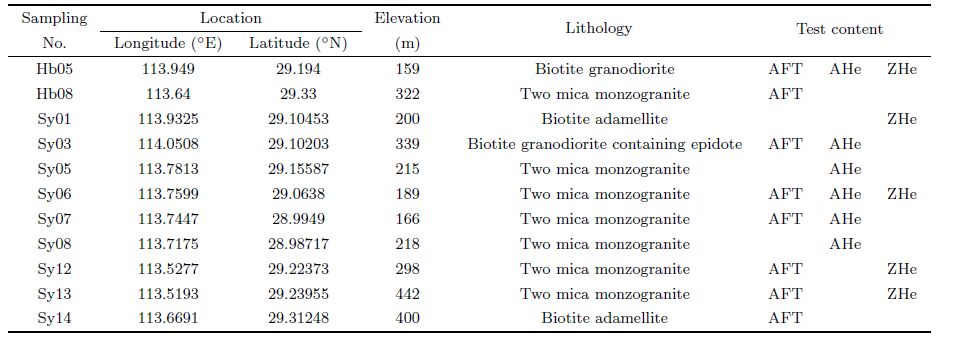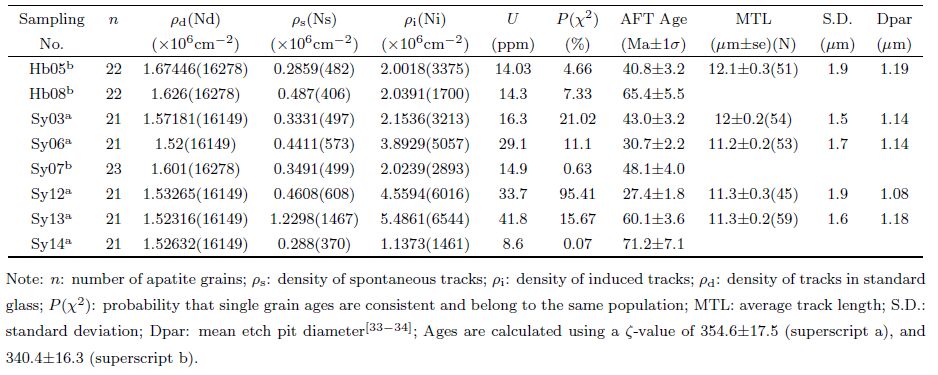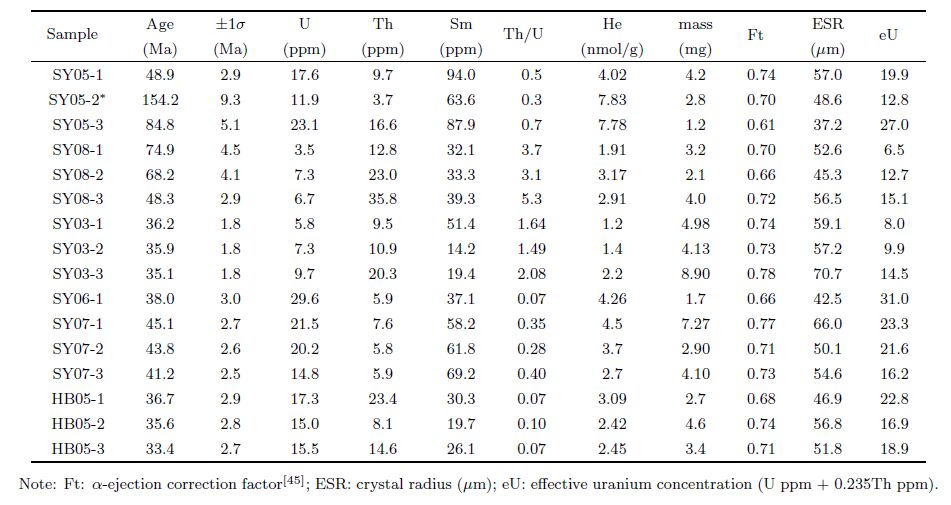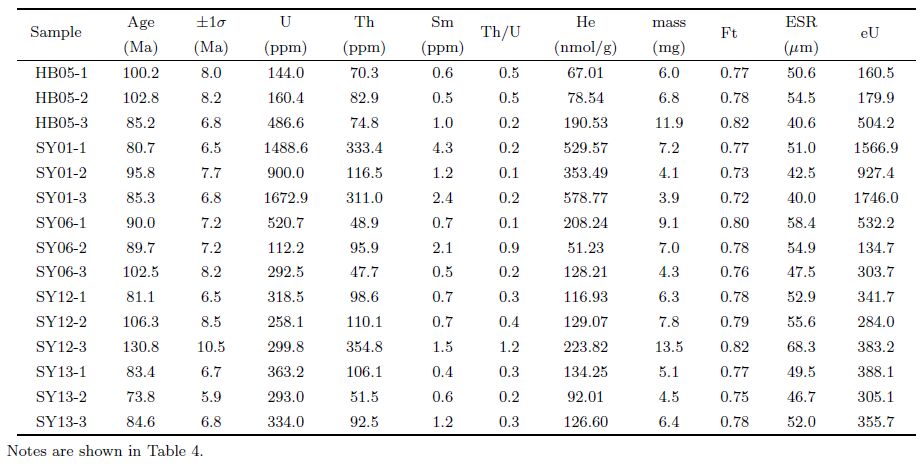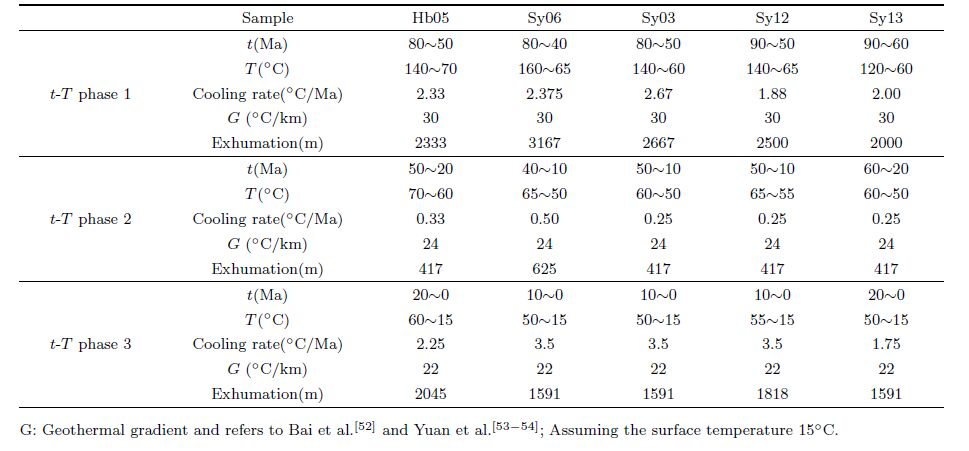2. University of Chinese Academy of Sciences, Beijing 100049, China
Jiangnan uplift is located in the collision zone between Yangtze and Cathaysia block,and extended to SW from the junction of Anhui and Zhejiang in the east,going through Hunan,Hubei,and Jiangxi up to the north of Guangxi (Fig.1). It is a polycyclic compound orogeny[1, 2],and formed a basin and range tectonic landscape in the NE-NNE direction together with the rift basins in the periphery[3] (Fig.2). The study area is located in the northern margin of the middle Jiangnan uplift,which is the conjunction of southeastern Hubei (Chongyang-Tongshan thrust fold belt),northeastern Hunan and northwestern Jiangxi. There was very intense tectonic activity,magmatism and mineralization in the study area,accompanying with the formation of rock masses[4, 5],and it was a crucial region for understanding the tectonic evolution in South China. Since 1950s,there were many studies on the forming mechanisms of granite and tectonic environment,spatial and temporal distribution and mineral resources,and concluded multi-phase and multi-stage granite petrogenesis,polymetallic mineralization[6, 7]. Because of the metamorphism and magmatism in pre-Cenozoic,large amount of K-Ar,Rb-Sr geochronology data was obtained,and it was useful to constrain the tectonic evolution history in Jiangnan and the periphery[2, 7, 8, 9, 10, 11]. People believed that it has undergone the process of multi-stage orogenesis,including the pre-Mesozoic Tethys continental collision orogeny,the Jurassic intracontinental convergence and strike-slip orogeny caused by the subduction of continental crust in Pacific plate since the Late Triassic and the transtensional intracontinental orogeny in Cretaceous-Neogene. The dynamics were successively controlled by the convergence between two largest ancient plates in Asia and the westward subduction and northward migration of the Pacific plate. However,because of the relatively weak tectonic movement and shallow tectonic level in Jiangnan uplift during Cenozoic,it did lack magmatic activity and the associated metamorphic minerals. Therefore,previous studies mainly concentrated in sedimentary tectonic history and other aspects[12]. There is no systematic research on thermochronology about crustal uplift,erosion,and the formation and evolution of mountain landscape in the northern margin of Jiangnan uplift. In theory,orogenic crumpling can result in crustal thickening and uplift,and then the inevitable erosion of the surface. Regional tectonic extension can also give raise to tectonic uplift and erosion of the shoulder block,accompanying with the formation of rift basin,etc. Uplift and denudation would inevitably lead to a decline of particle temperature in the crust. Therefore,the detailed low-temperature thermochronological study can determine not only the crustal uplift,but also help to reveal the tectonic evolution since Cenozoic. At the same time,tectonic evolution of Jiangnan uplift belt plays an important role in controlling Early Paleozoic hydrocarbon accumulation and preservation of Yangtze block,as the focus of today’s oil and gas exploration area in South China[13]. So,the detailed study about tectonic deformation and evolution mechanism of Jiangnan uplift also has important practical significance.
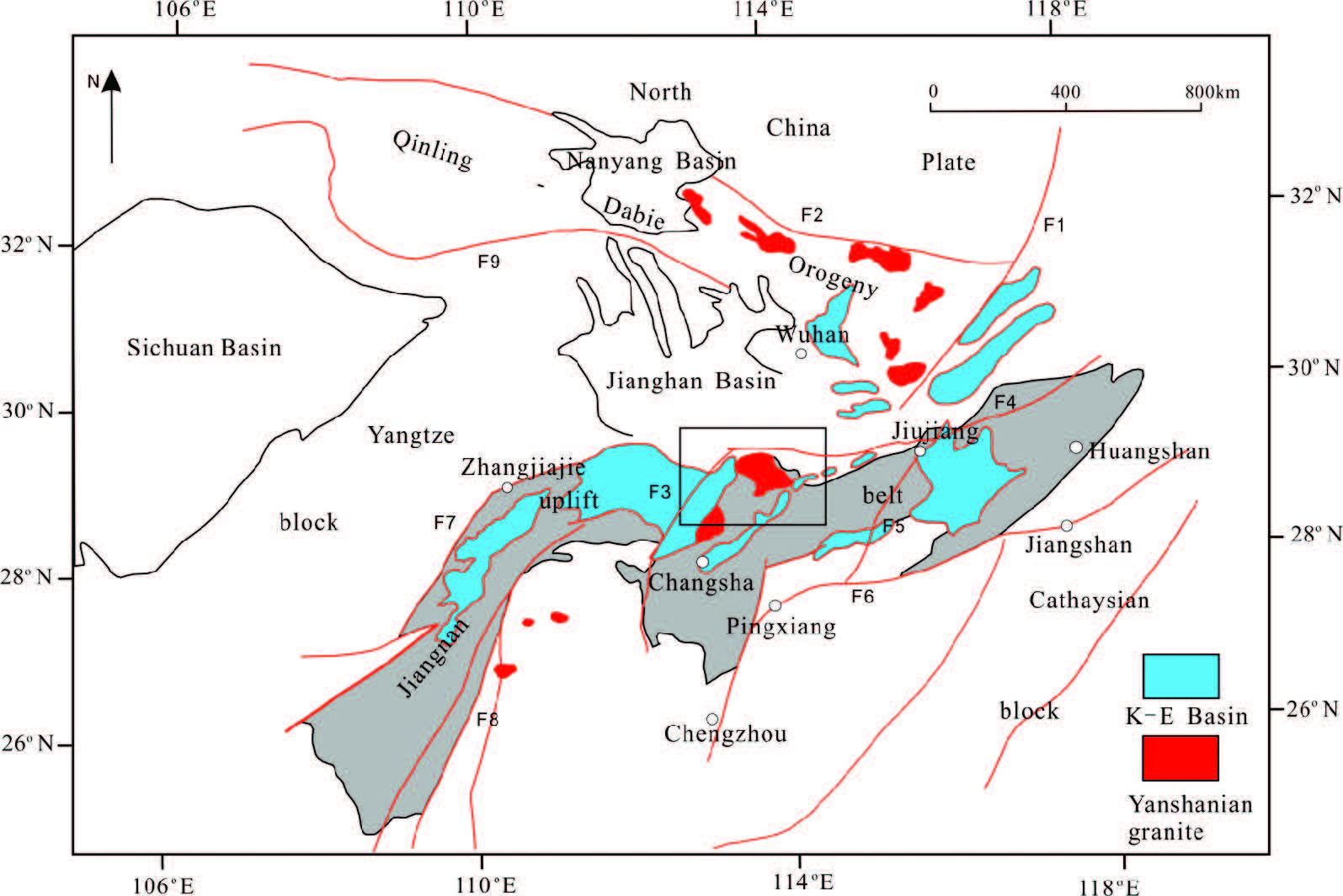
|
Fig.1 Structure map of Jiangnan uplift and location of study area Tanlu fault; F2: Xiangfan-Guangji fault; F3: Yueyang-Xiangyin fault; F4: Jiangnan fault; F5: Ganjiang fault; F6: Jiangshan-Pingxiang fault; F7: Xufu-Zhangjiajie fault; F8: Huaihua fault; F9: Jingshan fault. |
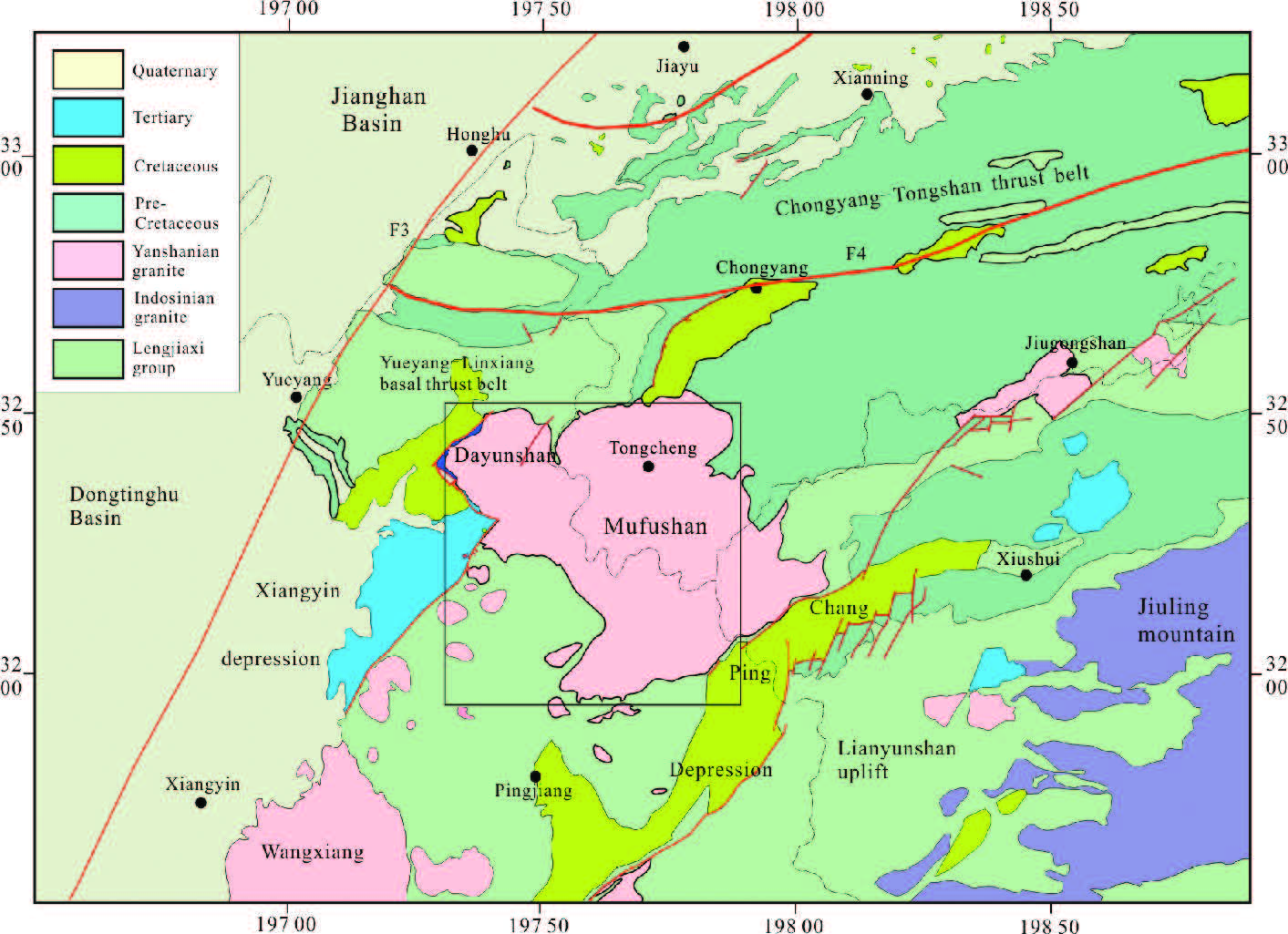
|
Fig.2 Simplified geological map of north Jiangnan uplift and its adjacent areas |
Apatite fission track (AFT) and apatite (U-Th-Sm)/He low-temperature thermochronology were successfully and extensively applied to rebuild the palaeogeothermal in oil and gas basins in recent years[14, 15, 16],the uplifting and cooling histories of orogeny and pluton[17, 18, 19, 20, 21, 22] and the exhumation of passive continental margin coastal zones and rift shoulder[23]. They are still widely used low-temperature thermochronology methods. Based on the summaries of regional tectonic movements and relevant geological events in the study area[2, 10, 24],this paper systematically analyzes the uplift and denudation history of study area by the low-temperature thermochronology methods since Cenozoic. Through analysis of AFT,(U-Th-Sm)/He data from Mufushan Yanshan intrusions and the thermal history inversions,this paper attempts to get the cooling thermal paths to explore Mufushan pluton uplifting,erosion history and basin-mountain coupling relationship,combining with tectonic evolution and basin fill record in the adjacent areas,and then quantitatively analyze the intracontinental orogenic processes and dynamic mechanism since Cenozoic in Mufushan and peripheral areas,which provide basic information for paleoenvironmental changes,mountain landscape evolution and hydrocarbon exploration.
2 GEOLOGY SETTING AND SAMPLINGJiangnan uplift in the southeastern margin of Yangtze block is an important tectonic element for a long time. It is separated from the Xuefengshan bulk by the Honghu-Xiangyin fault (F3) to the west and from Huaiyushan bulk by Guangjiang fault (F5) to the east,and the middle is Mufushan bulk[25]. The north edge of study area is Jiangnan fault (F4),and the south edge is Jiangshan-Pingxiang fault (F6) (Fig.1). Its neighbors are Jianghan depression to the north,and Pingle depression to the south. It was a marine basin and received stable sedimentation during Early Paleozoic. The sedimentation was dominated by carbonate rocks and was ended by collision between Yangtze block and Cathaysia block in Caledonian,accompanying the formation of Jiangnan uplift[12, 26]. From the Late Triassic,the Chinese mainland ended the marine sediments,and then exchanged into the intracontinental evolution stage. In the Early Yanshan Period,the Jiangnan uplift and adjacent areas were under tectonic compression,accompanied by development of lots of overthrust structures widely. Middle-Lower Yangtze block transformed into the Pacific Ocean tectonic domain in the Late Yanshan Period (Late Jurassic-Early Cretaceous),and at the same time a tectonic inversion happened in Jiangnan uplift and the peripheral zone. Under extension there developed a series of NE-trending normal faults and rift basins[27] and lots of granitic intrusive and volcanic basins,which together formed the basic structural framework of a NE-NNE trending tectonic magmatic belt and superposed basin-ridge mountains chain in northern Xiangdong. After that Jiangnan uplift belt entered Cenozoic tectonic evolution stage dominated by the compression in Late Himalayan,which resulted in uplifting and denudation with low folding,in response to the subduction between the Pacific plate and the Chinese mass and the collision between India plate and Chinese mass in the Sanjiang region in west. In the study area the folded basement was mainly dominated by epimetamorphic rock of Proterozoic and sedimentary cover including rift clastics (Nh-Z),marine carbonate (—C-T2),clastic continental margin rock (T3-J),and rift basin sediments (K2-E). A series of northward thrusting and N-E trending nappe was developed in the Chongyang-Tongshan thrust fold belt in the north of Jiangnan uplift.
In the study area there were multi-stage magmatic activities since it entered into Indosinian intracontinental evolution stagen,among which the most intense and widespread was in the Yanshan stage. The samples of this paper were obrained from the north end of the NE-trending northeast Hunan Mesozoic tectonic magmatic belt (some exposed in Tongcheng county in southeastern Hubei),which extended into northwestern Jiangxi. The major rock outcrops include Lianyunshan,Wangxiang,Jiugongshan pluton and so on in the periphery of Mufushan (Fig.2),the formation age span of which is between 195~110 Ma[7, 28],most belong to Yanshan stage. Early Cretaceous granitic rocks are mainly distributed in Mufushan and Wangxiang,aged 136 to 129 Ma (Muscovite K-Ar ages)[29]. Outcropping of Mufushan granites is in the form of bedrock and large stock,distributed in NE on the whole (Fig.2),which was controlled by regional tectonics obviously (e.g. Xiangyin fault and Changping fault). In the southeast of study area there is the Changping depression and in the northwest the Xiangyin depression. It was the sedimentary source area to Chongyang-Shicheng rift basin in the northern edge[30]. Mufushan pluton magma intrusion occurred at least four times,namely gabbro diorite,two mica monzogranite,biotite granite and biotite granodiorite,and dominated by the medium-grained porphyritic biotite granite[29]. The intrusive contact relation between granite rock and Upper Cambrian,Lower Ordovician and Middle-Lower Silurian could be seen in the north and the interfaces were curved with large contact surface inclination. Other wall rock was mainly Proterozoic Lengjiaxi Group metasedimentary rock. The rock erosion was very weak,and rock relics can be found in some sections.
In order to reveal the cooling and exhumation history of Mufushan pluton,we collected 11 samples from fresh outcrops and every one weighted over 2.5 kg. Sample information can be seen in Table1 and Fig.3. Their positions and elevations were determined by Garmin GPS12.
| Table 1 Samples information from Mufushan |
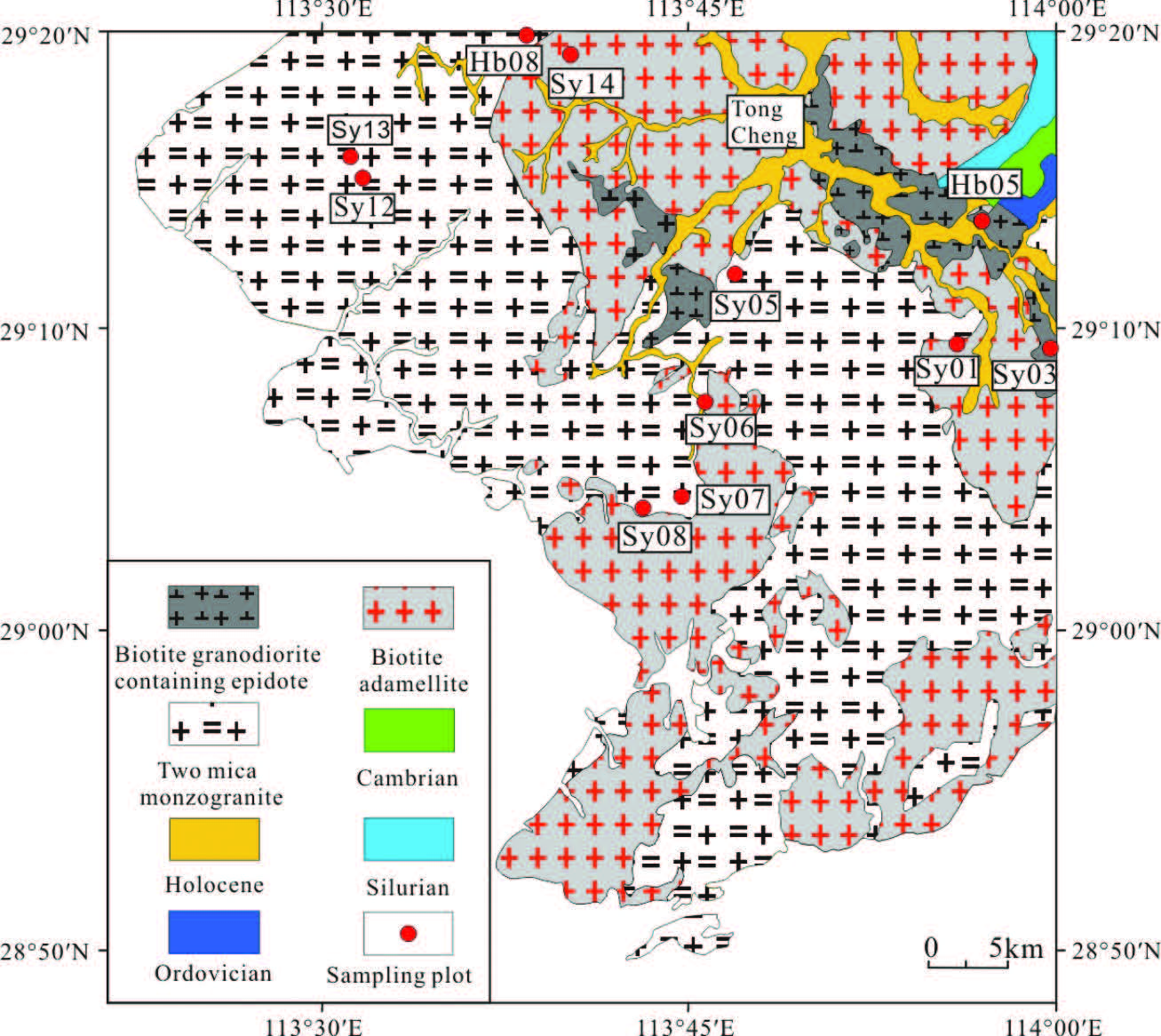
|
Fig.3 Geological map of Southwest Mufushan complex batholith (modified from Zou et al., 2011)[29] |
Spontaneous fission track was produced and left in minerals by 238U atomic fission,and the process of track repair (annealing) was controlled by thermal history experienced. We can obtain thermal history information through the analysis of sample fission trace technology,such as fission track density (track age) and confined track length distribution. The sensitive temperature range (closure temperature) of apatite fission track (AFT) is about 110~60°C. Apatite fission track analysis was carried out with the external detector method at Institute of Earth Science,University of Heidelberg and the analytical procedure in this paper is the same as that described in Ref.[31]. The mounts were then polished and etched in 5.5N HNO3 for 20(±1) seconds at 20(±1)°C to reveal the natural spontaneous fission track[32]. Durange apatite known uranium concentration was used as the age standards in this paper. The neutron dose was measured using the known uranium concentration standard glass CN5 glass. Samples were irradiated with neutron in Munich research reactor FRMII. After irradiation,the detection mica was etched in 48% HF for 20(±1) min at 20(±1)°C to reveal induced fission track. Area densities of fission track,horizontal confined fission track lengths and C-axis oriented etch pit diameters (Dpar)[33, 34] were determined in FT-1 system. The operation software was Autoscan software Trackscan. Apatite fission track ages were determined using the Zeta calibration method and Zeta factor of 354.6±17.5,340.4±16.3 were obtained by counting several Durange apatite age standards,respectively. All age and 1σ errors and age radial diagram were determined by using the computer code Trackkey[35].
(U-Th-Sm)/He age was determined using the laboratory procedures described in Ref.[36]. The sensitive temperature range (closure temperature) of AHe and ZHe are about 40~80°C and 130~200°C,respectively[37],and the closure temperature is about 70°C,180±20°C. The helium ages (AHe and ZHe) were carried out at the University of Kansas. The inclusions-free apatite/zircon grains with good idiomorphism and crystal width >70 μm were selected,and then photographed and measured in order to correct for α-ejection at first. After that they were wrapped in acid-treated Pt foil and heated for 5 minutes at 1070°C by Nd-YGA laser heater and subsequently reheated to ensure complete degassing for apatite,and zircons were wrapped in Pt foil,heated for 10 minutes at 1290°C and reheated until the He was extracted from the crystal. About 0.4pmol of 3He was added in 4He extracted before,and then the 4He/3He was aggregated and purified in cold conditions (16~37K),and measured using Quadrupole Mass Spectrometer. Apatites were spiked using an enriched 235U-230Th-149Sm tracer and dissolved in HNO3. Zircons were unwrapped from Pt foil and dissolved using HF-HNO3 and HCl pressure vessel digestion procedures. U,Th,and Sm concentrations were determined by isotope dilution ICPMS analysis. Reported age uncertainties (2σ) reflect the reproducibility of replicate analyses of laboratory standard samples. Estimated analytical uncertainties are 6% (2σ) for apatite and 8% (2σ) for zircon He ages,respectively.
4 MEASUREMENT RESULTS 4.1 AFT AgesApatite fission track results of 8 samples are listed in Table2. The central age ranges 27.4±1.8 (Sy12)~71.2 ±7.1 Ma (Sy14). Three of them (Hb05,Sy07 and Sy14) endow with high age dispersion (Pχ2) <5%),showing their ages are mixed with different age groups and the decomposition of these grain ages is necessary. The decomposition results calculated by BinomFit[38, 39] (http://earth.geology.yale.edu/~markb) are listed in Table3. Due to P(χ2) <5% of the samples,we choose the smaller component age as the age of the samples[40]. So,the ages of these three samples range from 27.4±1.8 (Sy12)~60.1±3.6 Ma (Sy13) (Miocene-Oligocene). Peng et al. (2004)[3] had come to a conclusion that apatite fission track age ranged from 45.2~55.6 Ma in Wangxiang rock mass. AFT ages from Jiugongshan rock mass ranged from 43.4~44.5 Ma[29]. The locations of sample can be seen in Fig.3. There were five samples obtained fission track lengths,and the distribution of them showed negative skew unimodality,peaked at 11~12 μm,which reflects a simple and monotonous cooling history with no significant reheating events since Cenozoic[41]. The obtained mean track length values show a restricted range between 11.3±0.2 (Sy13)~12.1±0.5 μm (Hb05),with relatively small standard deviation between 1.5~1.9 μm,which are shorter than the fresh track length (16.3 μm),showing that the sample experienced a high degree of annealing effects in partial annealing zone (about 110~60°C). In addition,Dpar values were determined for the five samples and showed a narrow range between 1.08~1.19 μm.
| Table 2 Apatite fission track data of Mufushan granite samples |
| Table 3 Compositional ages of AFT by BinFit |
For the apatite (U-Th-Sm)/He (AHe) analysis,six samples with 3 grains each were measured,except Sy06,and the results were listed in Table1 and 4. The repetition rates of Sy03,Sy07 and Hb05 are better than other two samples’. The ages of the former and Sy06 mainly focus in 33.4~43.8 Ma (Miocene),younger than their AFT ages,which shows that these samples experienced a more rapid cooling event during Miocene-Oligocene. AHe age was intensely reset,but not completely in Miocene,indicating the experienced temperature was below 75°C,and the cooling rate is less than 2.4°C/Ma since Miocene. Samples Sy05,Sy08 of AHe ages were 48.9,84.8 Ma and 74.9,68.2,48.3 Ma respectively. Taking into account that AFT ages with the higher closure temperature range were only 27.4±1.8~60.1±3.6 Ma,the youngest AHe ages were believed as the age of the samples,because of their representativeness. AHe ages were much more disperse due to the inhalation (during the α-particle diffusion process,α-particle of apatite crystal enters into another crystals),which made the affected He ages older than normal and it could be a response to eU[42, 43, 44]. There is a good correlation between AHe age and the eU (Fig.4) for these samples with a low repetition rates except Sy08,but no systematic relationship for nothers.
| Table 4 Apatite (U-Th-Sm)/He results of samples from Mufushan |
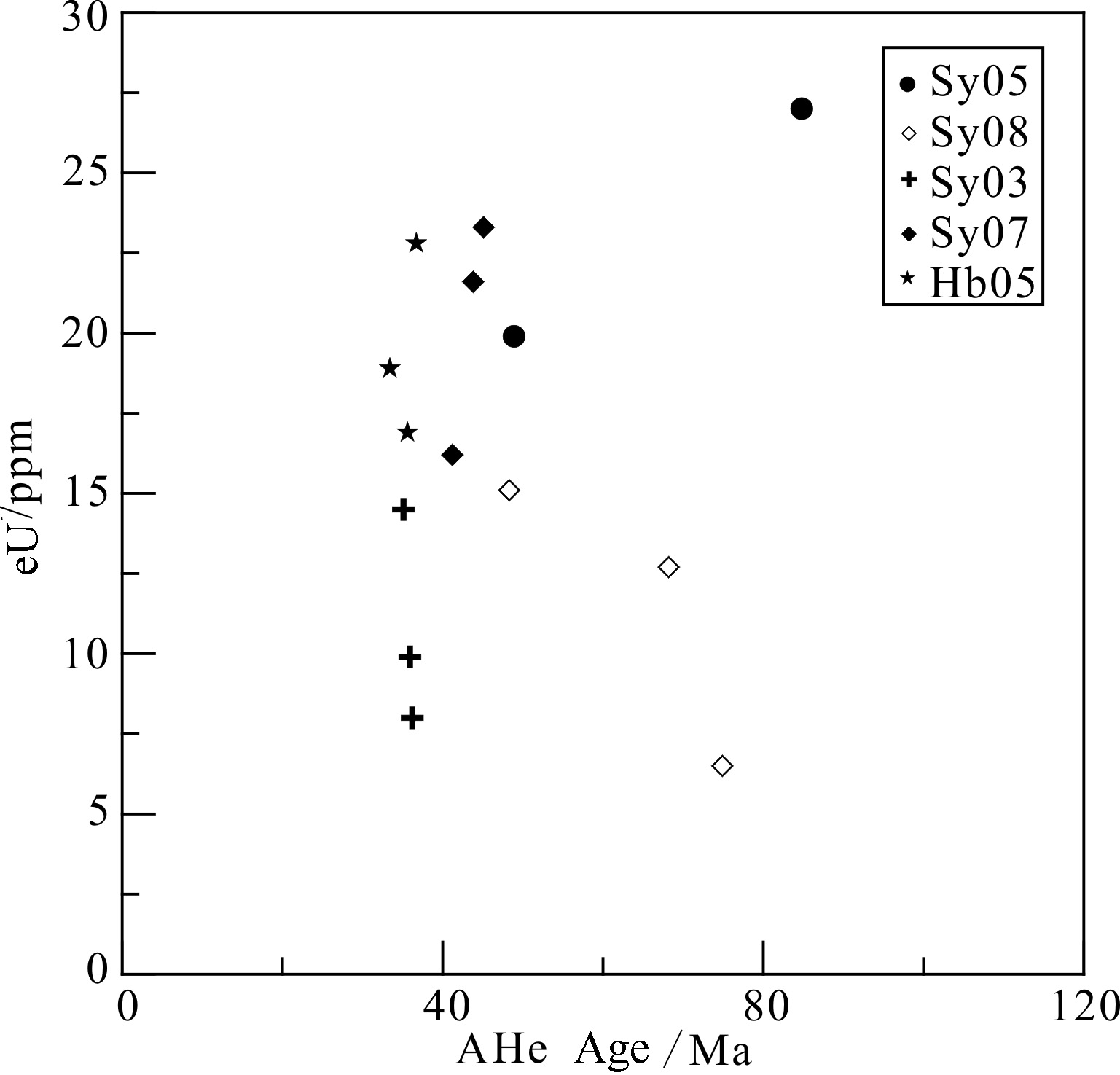
|
Fig.4 The relationship between the corrected AHe ages and eU |
Five samples were also measured for Zircon (U-Th-Sm)/He (ZHe) analysis with 3 grains (Table1 and 5). The ZHe ages range from 73.8±5.9~130.8±10.5 Ma,and are older than AFT ages. The ZHe age distribution peak is about 80 Ma (Fig.5),showing that the samples had been cooled at ~80 Ma to about 160°C.
| Table 5 Zircon (U-Th-Sm)/He results of samples from Mufushan |
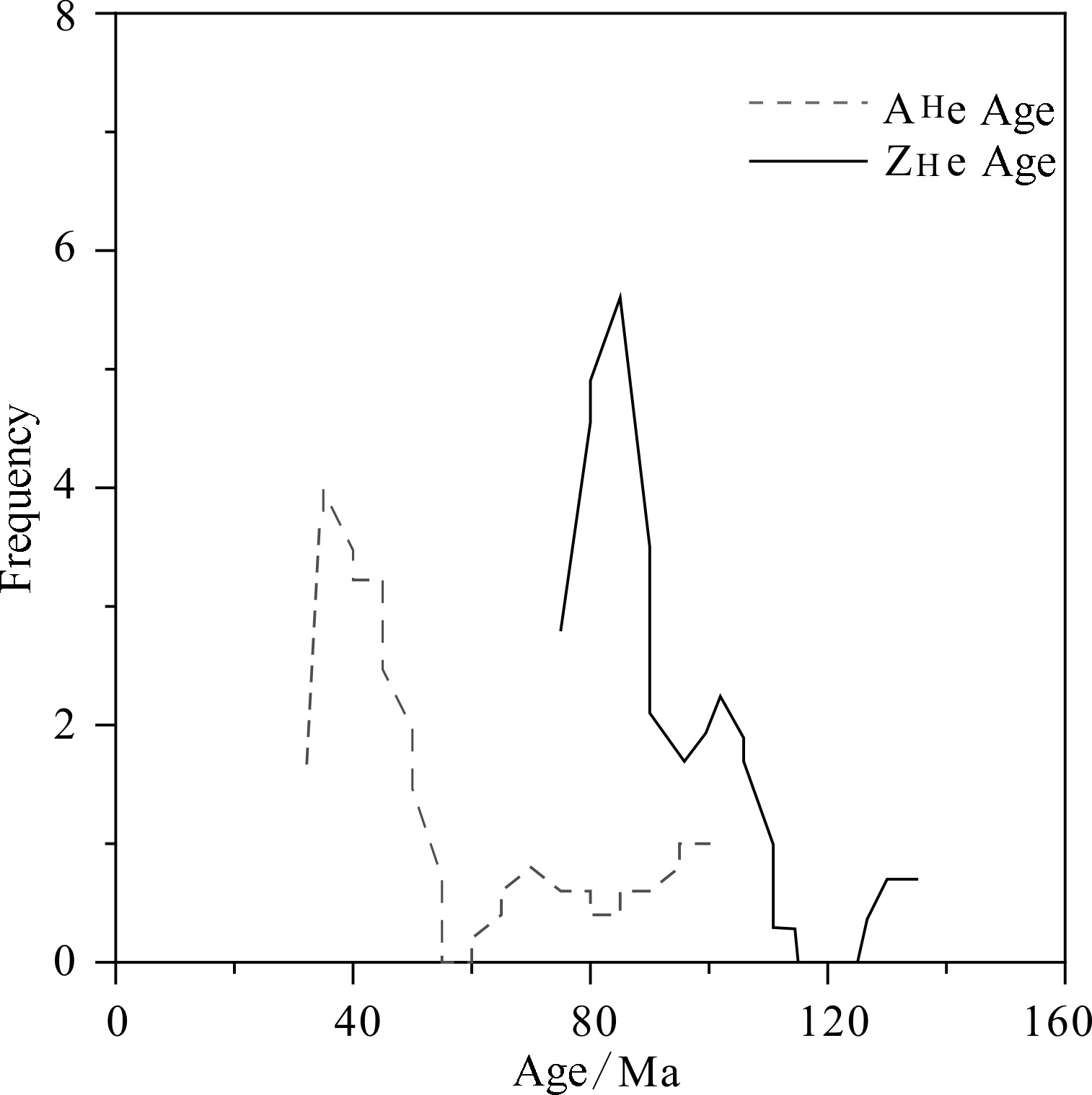
|
Fig.5 Distribution plot of AHe and ZHe ages |
Apatite fission track apparent age has no direct geological significance[23]. However,combined with fission track length distribution and apatite annealing kinetic parameters,we can better simulate the thermal history to reveal the tectonic evolution process. The apatite multivariate dynamics model[46, 47] and Monte Carlo Approximation method and thermal history modeling software HeFTy[48] were used to simulate the thermal history of samples in this paper.
Constraints from geological background for apatite fission track thermal inversion are extremely important. Three constraints were introduced during thermal history inversion process: the first one is today surface temperature; the AFT and AHe ages were considered the second constraint,and the last was the closure temperature of ZHe. Although temperature curve shape is not affected by the simulation starting time,but it would slightly affect the convergence time of temperature curve. Corrigan (1991)[49] provided the estimation formula on starting time t = [lo/(l - σ)]tFTA (lo is fresh fission track length; l is the measured average fission track length; σ is the standard error of fission track length[19]). Under the above conditions,to get the best t-Tcurve,it needs to loose the restrictions as much as possible.
According to the measured and simulated track length and age test value (GOF),Ketcham (2005)[48] divided the simulation results into three parts: acceptable thermal history curve area,preferably thermal history and the best range of thermal history curve fitting curve. If the age and length GOF test are greater than 0.05,it indicates that the simulation results are acceptable; when they exceed 0.5,the simulation result is better. The length distribution tests of samples from 0.55 to 0.87,age test GOF from 0.63 to 0.97,are greater than 0.5 (Fig.6),which indicates the simulated results are best,and can be used to reflect Mufushan Cenozoic rock uplift and exhumation process. The inversion results are shown in Fig.6. The shapes of t-Tpaths are basically the same. The results show that thermal history of Mufushan rock since the Cenozoic is a gradual cooling process,and according to the cooling rate changes it can be broadly divided into three phases: rapid-slow-rapid cooling process.
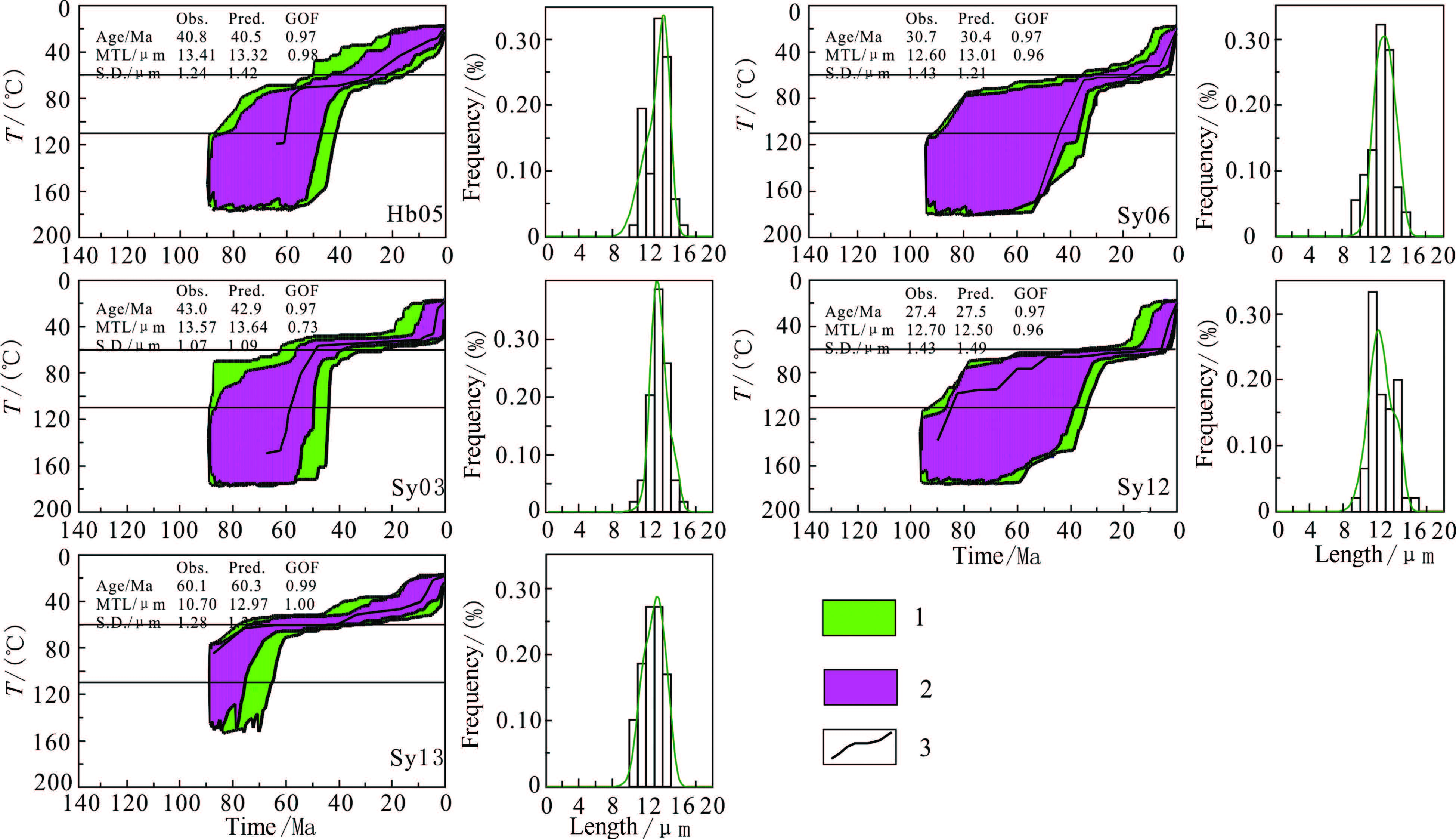
|
Fig.6 Inversed results of thermal history by AFT from Mufushan plutons 1: Acceptable paths with GOF between 0.05 and 0.5; 2: Good paths with GOF more than 0.5; 3: Best fit. AHe and ZHe ages are not modeled because of their probable eU dependence, but used as geological constraints and plotted along t-T paths, where available. |
Temperature of samples entered into the apatite fission track partial annealing zone (PAZ) in Late Cretaceous,and to PAZ lower limit after about 30 Ma of rapid cooling,followed by a slow cooling ending at 20~10 Ma. If we calculated the exhumation of Mufushan according to the average geothermal gradient listed in Table6,it will be up to 4800 m since Late Cretaceous. The first stage was the process of rapid cooling,and the average cooling rate was about 2.25 δC/Ma. The cooling rate significantly reduced during 50~10 Ma,about 0.32 δC/Ma. After 10 Ma,the average cooling rate was about 2.9 δC/Ma. The analysis results were shown in Table6. Wang et al. (2009)[29] analyzed fission track thermal history of Jiugongshan rock and indicated that there were two rapid cooling stages in 120~55 Ma and since 9 Ma respectively,and thought the exhumation was up to about 6000 m since Yanshan (assuming geothermal gradient of 28 δC/km). This shows they underwent the same t-Thistory on the whole,but there is a difference in denudation in different regions. Hu et al. (2005)[50] calculated the AFT cooling history of Qinling-Dabie-Sulu in north study area and believed that there were two rapid cooling processes during 100~80 Ma and since 20~10. It has similar cooling process with the Middle-Upper Yangtze (western Hubei and Hunan andWestern Hubei and Eastern Chongqing)[51]. The Middle-Lower Yangtze was in a significant extensional stage during Late Yanshanian-Early Himalayan because of the impact of Pacific tectonization[11]. In the context of extension,the study area and adjacent areas (southeastern Hubei,Jianghan basin,etc.) developed K2-E rift basins,accompanying with tectonic uplift and exhumation along its shoulders. However,the denudation became weaker gradually in Qinling-Dabie-Sulu and Middle-Upper Yangtze thrust fold belt because the compression from southeast decreased due to the extension in East China. It can be seen that the impact of extension in late Yanshanian has been limited in the Middle-Lower Yangtze. To the contrary,in the late Himalayan rapid cooling process has been recorded in the entire Yangtze Block and Qinling-Dabie orogen,indicating that the effect of compression is extensive. In short,the Yangtze block experienced a different tectonic evolution process in the Cenozoic in different positions. The structural dynamics of Upper Yangtze was single and the compression was sustainable,while in the Middle-Lower Yangtze mechanical properties were complex and multiple tectonic deformation and structural inversion can be seen.
| Table 6 Inversed thermal histories of the 5 samples |
6.2 Basin-mountain Coupling and Relationship Between Sedimentary and Tectonic Evolution Mufushan Cenozoic rocks experienced complex thermal events and an inhomogeneous uplift process spatially. In the study area an acidic magma emplacement extensively happened and formed Mufushan,Wangxiang,Lianyunshan acidic intrusion and NE-trending Jiuling-Mufushan magmatic belt[3]. To about 80 Ma,Mufushan rock cooled to apatite fission track PAZ upper limit. Bai et al.[30] concluded that the strata dip of Late Cretaceous-Paleocene Baihuating group was higher in northwest than in the southeast of Xiangyin depress in the left of Mufushan Mountain; and the sedimentary conglomerate compositions changed from Lengjiaxi slate to granite gravel in southeast suddenly,which showed Xiangyin Depression in Late Cretaceous-Paleocene experienced a rapid rift event that led to depression substrate rotation and inclination from northwest to southeast and rapid uplift and exhumation of rock in Mufushan Mountain. The early sedimentary source rocks of Xiangyin depression (lower part of Baihuating group) were mainly from Lengjiaxi slate,but granite gravel[30]; the late sediments (upper part) were mainly composed of granite rock,and there was an unconformity between Cretaceous and Jurassic strata,thus revealing starting time of uplift and erosion of Mufushan rocks. This granitic conglomerate near mountain was limited in the Late Cretaceous strata,indicating the phased uplift process; while the strata can be widely seen in the Dongting Lake basin ,Changping basin and Chongyang-Shicheng depression,indicating that the rapid uplift process was universal[55]. Jiangnan Orogen experienced several compression collision orogenies during pre-Cretaceous under the control of the convergence between two giant plates in ancient Asia and the subduction of Pacific plate in Late Triassic. However,the study area and adjacent areas experienced intracontinental trans-tensional orogeny during Cretaceous-Paleogene because of the isostatic compensation and successive northward movement of the Pacific plate[11].
Zhu et al.[12] showed that during 75~61.5 Ma (Late Cretaceous-Early Paleocene) the study area has undergone significant tectonic and hydrothermal activity according to ESR test results of quartz veins from the northern margin of Jiangnan uplift. Wang et al.[29] considered that there was a rapid cooling process in 120~55 Ma in view of apatite/zircon fission track thermal history simulation results of Jiugongshan rock. Combining with the comprehensive analysis of regional geological phenomena,it is thought that the NNE-NE trending faults formed in Indosinian-early Yanshan began to stretch and rift in late Yanshan which result in the forming of a series of NE trending rift basins on different tectonic units (Xiangyin depression,Chongyang-Shicheng depression and Changping depression,etc.). Paleogene lacustrine strata were deposited in these depressions until Himalayan. In Late Cretaceous-Paleogene Jianghan-Dongting basin was of the intracontinental rift basin nature,which was confirmed by different researchers[2, 56, 57]. However,these strata within the rift basin were formed axially roughly consistent with the folds and fault strike and there were thrusting activities from basin margin to central reaching its peak during the Eocene[56]. This paper argues that the overthrust and nappe tectonics may be formed in the context of gravity gliding action[58] rather than the effect of compression. When the rift basin was formed in the context of extensional tectonics,the edge shoulder (e.g. Mufushan rock) was accompanied by long-term uplift and gravity slippage,resulting in the rapid tectonic denudation and weathering,and the exhumation can be up to about 2500 m.
After about 50 Ma (Eocene),Eocene Zhongcun group began to be formed in Xiangyin depression,which consists of a thick layer of conglomerate,pebbly feldspar quartz sandstone,greywacke,siltstone,pebbly sandstone and mudstone,and conformity to Baihuating group[33]. It just means that Mufushan denudation rate reduction in Eocene lead to a significant reduction of granite gravel in Zhongcun group and it accords with the second stage of thermal history modeling results. Since about 50 Ma,planation surface of Class I was formed preliminarily in Neogene (Miocene)[59]. The slow cooling process of Mufushan rock may be associated with the formation of regional ancient planation surface and summit plane. Wang et al.[32] alleged Jiugongshan pluton also had a slow denudation phase during 55~9 Ma. In this phase denudation significantly reduced to an average about 450 m.
The thermal history results also showed that Mufushan rock since about 20~10 Ma experienced a rapid cooling process. Since Eocene-Oligocene,the Pacific Plate was moving westward,resulting in a sustained compression,regional uplift in Mufushan and adjacent areas and tectonic inversion. Due to the sudden westward movement of Pacific Plate ,Mufushan Mountain produced near-NS principal stress,resulting in folding in Jiangnan uplift zone and adjacent basins. Overall uplift caused a hiatus in Neogene,and the unconformity was formed between Paleogene and Neogene[56]. Some sedimentary basins were transformed from rift basin during Paleogene into depression basin in Neogene,for example,Xiushui basin and Jianghan Basin,accompanying with the resurrection and development of thrust faults from the margins to the center of the basin[12] and the red layer deformation and folding formed in EW trend. Zhu et al.[12] also demonstrated by ESR ages (23.9~9.9 Ma) that a series of near-NE-trending strike-slip faults formed by the Tan-Lu and Ganjiang fault early activities in the study area (such as Yueyang-Xiangyin fault) revived sinistral strike-slip under SN-trending compression in the late Himalayan. These show that the central part of Jiangnan uplift belt experienced a compression and uplifting during late Himalayan (mid-Miocene Himalayan Episode II,25~10 Ma). Red basin was uplift and eroded gradually due to the compression and formed a multi-level planation surface[59]. Denudation of Mufushan rock can be up to an average of about 1700 m since late Himalayan,which is slightly different with Jiugongshan rock (since 9 Ma)[29]. Uplifting and erosion of Mufushan rock in Late Himalayan and peripheral K2-E rift basin inversion mechanism may be universally related with the movement rate of the Pacific plate and the convergence between several large plates.
7 CONCLUSION(1) Thermal history inversion results combining with the apatite fission track and apatite/zircon (U-Th-Sm)/He show that the denudation cooling process of Mufushan since the Late Cretaceous can be divided into three stages: 1) cooling rate was about 2 δC/Ma during 80~50 Ma (Late Paleocene); 2) cooling rate was 0.5 δC/Ma during 50~10 Ma; 3) cooling rate was 2.5 δC/Ma since 10 Ma,two of which were rapid erosion processes and a slow cooling period,and the denudation can be up to 4800 m in all.
(2) Effect of extension in late Yanshanian was limited in the Middle-Lower Yangtze area. However,the effect of rapid cooling process in the late Himalayan can be extensively seen in the entire Yangtze block and Qinling-Dabie in response to the compression.
(3) Sediment lithological composition in depressions and the rheological property evolution of basin margin fault were controlled by uplifting process of Mufushan. Three-stage cooling history was consistent with regional tectonic setting respectively: the rift activity of NNE-NE trending faults formed in early Indo-Yanshanian began from late Yanshan and lasted until the Himalayan. At the same time,Mufushan experienced a rapid tectonic uplift and denudation,resulting in the Paleogene lacustrine strata in depressions. After about 50 Ma (Eocene),the cooling rate decreased due to the formation of regional planation surface and peak surface. The compression caused by westward movement of the Pacific plate during Eocene-Oligocene accelerated the uplift and cooling rate. The tectonic evolution of Mufushan block and adjacent areas since the Late Cretaceous was mainly controlled by tectonic activities in the Pacific region.
8 ACKNOWLEDGMENTSWe thank Eizenhofer Paul,Rene W. Grobe and F. U. Bauer for their helps in fission track lab of Heidelberg University. Also we like to thank Deniel Stockli from Kansas University for works on measurement of helium age data. We are especially grateful to two anonymous reviewers.
| [1] Sylvester P J. Post-collisional strongly peraluminous granites. Lithos, 1998, 45(1-4):29-44. |
| [2] Fu Z R, Li Z J, Zheng D Y. Structural pattern and tectonic evolution of NNE-trending strike-slip orogenic belt in the border region of Hu'nan and Jiangxi Province. Earth Science Frontiers (in Chinese), 1999, 6(4):263-272. |
| [3] Peng H Q, Jia B H, Yang X S. Uplift process of Mufushan and thermalchronology of Wangxiang granites in northeast Hu'nan Province. Geological Science and Technology Information (in Chinese), 2004, 23(1):11-15. |
| [4] Jin W Q, Liu H Q, Zhang L X, et al. Study on rock- and ore-controlling structures in northeastern Hu'nan Province. Geology and Mineral Resources of South China (in Chinese), 2000, (2):51-57. |
| [5] Liu X N, Kon, F H, Yang P, et al. Distribution and basic characteristics of small intrusions in Southeast Hubei. Resources Environment and Engineering (in Chinese), 2009, 23(4):390-395. |
| [6] Chen J F, Jahn B M. Crustal evolution of southeastern China:Nd and Sr isotopic evidence. Tectonophysics, 1998, 284(1-2):101-133. |
| [7] Li P C, Xu D R, Chen G H, et al. Constraints of petrography, geochemistry and Sr-Nd isotopes on the Jinjing granitoids from northeastern Hu'nan province, China:implications for petrogenesis and geodynamic setting. Acta Petrological Sinica (in Chinese), 2005, 21(3):921-934. |
| [8] Li Z X. Tectonic history of the major East Asian lithospheric blocks since the mid-Proterozoic:A synthesis.//Flower M F J, Chung S L, Lo C H, et al. eds. Mantle dynamics and Plate interactions in East Asia. America Geophys. Union (Geodynamic Series), 1998, 27:221-243. |
| [9] Zhou X M, Li W X. Origin of Late Mesozoic igneous rocks in Southeastern China:implications for lithosphere subduction and underplating of mafic magmas. Tectonophysics, 2000, 326(3-4):269-287. |
| [10] Li X F, Fu Z R, Li J W, et al. Strike-slip tectonics trending NNE in the area of eastern Hu'nan and western Jiangxi, China. Geotectonica et Metallogenia (in Chinese), 2001, 25(2):136-140. |
| [11] Guo X S, Mei L F, Tang J G, et al. Constrains of Meso-Cenozoic tectonic evolution of Yangtze massif on formation of marine reservoirs. Oil and Gas Geology (in Chinese), 2006, 27(3):295-304, 325. |
| [12] Zhu Q B, Yang K G, Cheng W Q. Structural evolution of northern Jiangnan uplift:evidence from ESR dating. Geoscience (in Chinese), 2011, 25(1):31-38. |
| [13] Ni X F, Chen H D, Wei D X, et al. Superimposing and rebuilding of the middle-upper Yangtze Basin and its prospects of oil and gas in marine strata. Acta Geological Sinica (in Chinese), 2009, 83(4):468-477. |
| [14] Hu S B, Wang J Y. Principles and progresses on thermal regime of sedimentary basins-an overview. Earth Science Frontiers (China University of Geosciences, Beijing) (in Chinese), 1995, 2(3-4):171-180. |
| [15] Qiu N S, Reiners P, Mei Q H, et al. Application of the (U-Th)/He thermochronometry to the tectono-thermal evolution of sedimentary basin-A case history of well KQ1 in the Tarim Basin. Chinese J. Geophys. (in Chinese), 2009, 52(7):1825-1835. |
| [16] Qiu N S, Chang J, Zuo Y H, et al. Thermal evolution and Lower Paleozoic source rocks maturation in the Tarim Basin, Northwest China. AAPG Bulletin, 2012, 96(5):789-821. |
| [17] Gleadow A J W, Brown R W. Fission-track thermochronology and the long-term denudational response to tectonics.//Summerfield M J ed. Geomorphology and Global Tectonics. New York:John Wiley & Sons, Ltd., 2000:57-75. |
| [18] Hu S B, Kohn P K, Raza A, et al. Cretaceous and Cenozoic cooling history across the ultrahigh pressure Tongbai-Dabie belt, central China, from apatite fission-track thermochronology. Tectonophysics, 2006, 420(3-4):409-429. |
| [19] Shi X B, Qiu X L, Liu H L, et al. Cenozoic cooling history of Lincang granitoid hatholith, western Yunnan:Evidence from fission track data. Chinese J. Geophys. (in Chinese), 2006, 49(1):135-142. |
| [20] Shi X B, Kohn B, Spencer S, et al. Cenozoic denudation history of southern Hainan Island, South China Sea:Constraints from low temperature thermochronology. Tectonophysics, 2011, 504(1-4):100-115. |
| [21] Qiu N S, Chang J, Li W Z, et al. New evidence on the Neogene uplift of South Tianshan:Constraints from the (U-Th)/He and AFT ages of borehole samples of the Tarim basin and implications for hydrocarbon generation. International Journal of Earth Sciences, 2012, 101(6):1625-1643. |
| [22] Qiu N S, Jiang G, Mei Q H, et al. The Paleozoic tectonothermal evolution of the Bachu Uplift of the Tarim Basin, NW China:constraints from (U-Th)/He ages, apatite fission track and vitrinite reflectance data. Journal of Asian Earth Sciences, 2011, 41(6):551-563. |
| [23] Gleadow A, Belton D, Kohn B P, et al. Fission track dating of phosphate minerals and the thermochronology of apatite. Reviews in Mineralogy and Geochemistry, 2002, 48(1):579-630. |
| [24] Rao J R, Xiao Y H, Liu Y R, et al. Location of the Yangtze-Cathaysia plate convergence zone in Hu'nan.Chinese J. Geophys. (in Chinese), 2012, 55(2):484-502. |
| [25] Ding D G, Liu G X. Progressive deformation in Yangtze plate-series 2 of the southern structure studies. Petroleum Geology and Experiment (in Chinese), 2007, 29(3):238-246. |
| [26] Ma W P, Qiu Y X, He F S. Lower Paleozoic omission zone in Jiangnan uplift-A sign of Caledonian foreland fold thrust belt. Geoscience (Journal of Graduate School, China University of Geosciences) (in Chinese), 1995, 9(3):320-324. |
| [27] Yu X Q, Shu L S, Deng P, er al. The sedimentary features of the Jurassic-Tertiary terrestrial strata in southeast China. Journal of Stratigraphy (in Chinese), 2003, 27(3):254-263. |
| [28] Wang S H, Luo K P, Liu G X. Fission track records of tectonic uplift during the Cenozoic and Mesozoic in the periphery of the Jianghan basin. Oil and Geology (in Chinese), 2009, 30(3):255-259. |
| [29] Zou H J, Ma C Q, Wang L X. A magma ascent rate of epidote-bearing granodioritic magma in the Mufushan comples batholith of NE Hu'nan Province:evidence from prtrography and mineral chemistry. Acta Geologica Sinica (in Chinese), 2011, 85(3):366-378. |
| [30] Bai D Y, Liu B, Ni Y J, et al. Characteristics of basin-controlling faults, basin type and dynamic mechanisms of the Xiangyin Sag in northeastern Hu'nan. Resources Survey and Environment (in Chinese), 2010, 30(3):157-168. |
| [31] Grobe R, Marron J A, Glasmacher U A, et al. Low-temperature exhumation history of Variscan-age rocks in the western Cantabrian Mountains (NW Spain) recorded by apatite fission-track data. Tectonophysics, 2010, 489:76-90. |
| [32] Grist A M, Ravenhurst C E. A step-by-step laboratory guide to fission track thermochronology at Dalhousie University.//Zentilli M, Reynolds P, eds. Short Course Handbook on Low Temperature Thermochronology. Mineralogical Association of Canada Short Course Handbook, 1992, 20:190-201. |
| [33] Donelick R A. A method of fission track analysis utilizing bulk chemical etching of apatite. U.S. Patent Number. 6, 267, 274. 1993. |
| [34] Donelick R A. A method of fission track analysis utilizing bulk chemical etching of apatite. Australian Patent Number 658, 800, 1995. |
| [35] Dunkl I. Trackkey:a Windows program for calculation and graphical presentation of fission track data. Computer & Geosciences, 2002, 28(1):3-12. |
| [36] Stockli D F, Farley K A, Dumitru T A. Calibration of the (U-Th)/He thermochronometer on an exhumed normal fault block in the White Mountains, California. Geology, 2000, 28(11):983-986. |
| [37] Wolf M R, Stockli D F. Zircon (U-Th)/He thermochronometry in the KTB drill hole, Germany, and its implications for bulk He diffusion kinetics in zircon. Earth and Planetary Science Letters, 2010, 295(1-2):69-82. |
| [38] Brandon M T. Decomposition of fission track dating grain-age distributions. American Journal of Science, 1992, 292(8):535-564. |
| [39] Brandon M, Roden T M K, Garver J I. Late Cenozoic exhumation of the Cascadia accretionary wedge in the Olympic Mountains, northwest Washington State. Geological Society of America Bulletin, 1998, 100(8):982-1009. |
| [40] Barnes J B, Ehlers T A, McQuarrie N, et al. Eocene to recent variations in erosion across the central Andean foldthrust, northern Bolivia:Implications for plateau evolution. Earth and Planetary Science Letters, 2006, 248(1-2):118-133 |
| [41] Gleadow A J W, Duddy I R, Lovering J F, et al.. Fission track analysis:a new tool for the evaluation of thermal histories and hydrocarbon potential. Aust. Pet. Explor. Assoc. J., 1983, 23:93-102. |
| [42] Fitzgerald P G, Baldwin S L, Webb L E, et al. Interpretation of (U-Th)/He single grain ages from slowly cooled crustal terranes:a case study from the Transantarctic Mountains of southern Victoria Land. Chem. Geol., 2006, 225(1-2):91-120. |
| [43] Flowers R M, Ketcham R A, Shuster D L, et al. Apatite (U-Th)/He thermochronometry using a dadiation damage accumulation and annealing model. Geochim Cosmochim Acta, 2009, 73(8):2347-2365. |
| [44] Chang J, Qiu N S. Closure temperature of (U-Th)/He system in apatite obtained from natural drillhole samples in the Tarim basin and its geological significance. Chinese Science Bulletin, 2012, 57(26):3482-3490. |
| [45] Farley K A, Wolf R A, Silver L T. The effects of long-alpha-stopping distances on (U-Th)/He ages. Geochimica et Cosmochimica Acta, 1996, 60(21):4223-4229. |
| [46] Ketcham R, Carter A, Donelick R A, et al. Improved modeling of fission-track annealing in apatite. American Mineralogist, 2007, 92(5-6):799-810. |
| [47] Ketcham R, Carter A, Donelick R A, et al. Improved measurement of fission-track annealing in apatite using c-axis projection. American Mineralogist, 2007, 92(5-6):789-798. |
| [48] Ketcham R. Forward and inverse modeling of low-temperature thermochronometry data. Reviews in Mineralogy and Geochemistry, 2005, 58(1):275-314. |
| [49] Corrigan J. Inverse of apatite fission track data for thermal history information. Journal of Geological Research, 1991, 96(B6):10347-10360. |
| [50] Hu S B, Hao J, Fu M X, et al. Cenozoic denudation and cooling history of Qinling-Dabie-Sulu orogens:apatite fission track thermochronology constraints. Acta Petrological Sinica (in Chinese), 2005, 21(4):1167-1173. |
| [51] Mei L F, Liu Z Q, Tang J G, et al. Mesozoic Intra-continental progressive deformation in western Hunan-Hubeieastern Sichuan provinces of China:evidence from apatite fission track and balanced cross-section. Earth Scince (in Chinese), 2010, 2(35):161-174. |
| [52] Bai D Y, Huang J Z, Meng D B, et al. Meso-Cenozoic thermochronological analysis of the uplift process of mountains in southeast Hunan. Acta Geoscientica Sinica (in Chinese), 2006, 27(6):525-536. |
| [53] Yuan Y S, Zhu C Q, Hu S B. Heat flow history, tectono-sedimentary evolution and thermal events of the Jianghan Basin. Progress of Geophysics (in Chinese), 2007, 22(3):934-939. |
| [54] Yuan Y S, Ma Y S, Hu S B, et al. Present-day geothermal characteristics in South China. Chinese J. Geophys. (in Chinese), 2006, 49(4):1118-1126. |
| [55] Xu D R, Wang L, Li P C, et al. Petrogensis of Lianyunshan granites in northeastern Hunan province, South China, and its geodynamic implications. Acta Petrologica Sinica (in Chinese), 2009, 25(5):1056-1078. |
| [56] Yao Y S, Luo D G, Liu S W, et al. Tectonic deformation of the Jianghan-Dongting Basin and its surrounding areas from late Mesozoic to Cenozoic. Geotectonica et Metallogenia (in Chinese), 2000, 24(2):140-145. |
| [57] Xu Z Y, Lu W Z, Lin G, et al. Discrepant uplifting processes of the Qinling-Dabie and Jiangnan orogens:evidence from Meso-Cenozoic sedimentary records in the Jianghan superimposed basin. Chinese Journal of Geology (in Chinese), 2005, 40(2):179-197. |
| [58] Zhu Z C. Thrust and Napped Tectonics. Wuhan:China University of Geosciences Press, 1991. |
| [59] Huang D H, Ye J L. A study on Neotectonics and dynamics of the north foot of Mufu Mountain. Earth Scinence-Journal of China University of Geosciences (in Chinese), 1990, 15(5):515-523. |
 2013, Vol. 56
2013, Vol. 56


